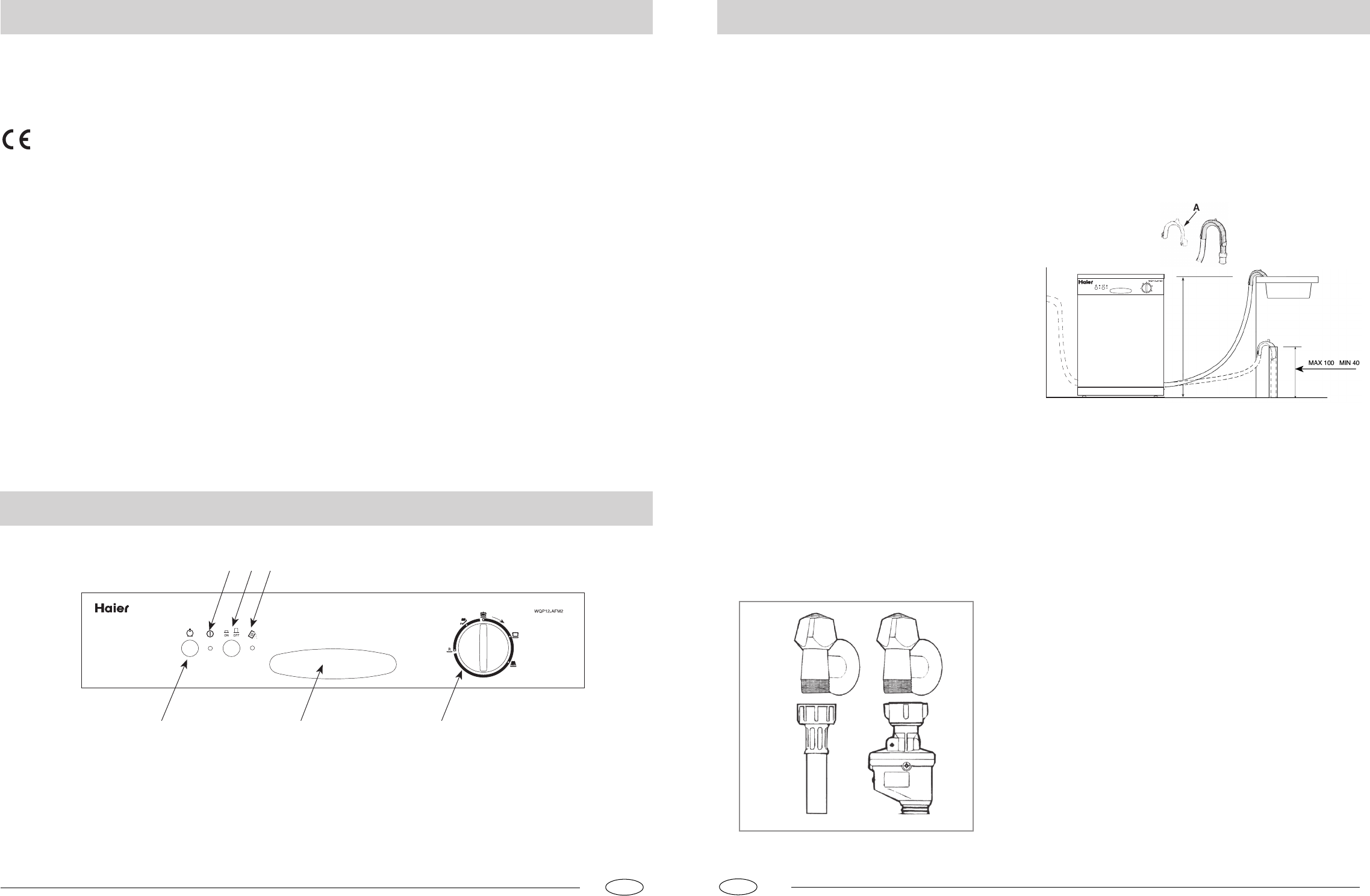
Safety Is a Good Habit to Get Into
Close-up View (Control Panel)
A
B
C
ON-OFF Light
ON-OFF Button
Handle For Opening Door
D
E
F
"Eco" Button
A B C
F
E
D
Knob For Selecting Cycle
Low Salt Indicator Light
NOTICE
Carefully read the instructions contained in this manual, as they
provide important information which is essential to safe and proper
installation, use and maintenance of the appliance.
This appliance complies with the following EEC
directives:
- 73/23/EEC of 19/02/73 (Low Voltage) and subsequent
modifications;
- 89/336/EEC of 03/05/89 (Electromagnetic
Compatibility) and subsequent modifications.
- Carefully dispose of the packing material.
- After removing the packing, check to make sure that the appli-
ance is not damaged. If in doubt, contact a qualified professional.
- The dishwasher must only be used by adults for the washing of
household dishes and cooking utensils.
- Fundamental rules to follow when using the appliance:
* Never touch the dishwasher when bare foot or with wet hands
or feet;
* We discourage the use of extension cords and multiple sockets;
* During installation, the power supply cord must not be exces-
sively or dangerously bent or flattened;
* If the appliance is not operating properly or maintenance must
be performed, disconnect the appliance from the power supply.
- Keep detergents out of the reach of children, who must also be
kept away from the dishwasher when it is open.
- This appliance cannot be installed outdoors, not even if the
area in which it is installed is covered by a roof; it is also very
dangerous to leave it exposed to the rain and elements.
- Do not touch the heating element during or after a wash cycle.
- Do not lean or sit on the door when it is open, as this could
overturn the dishwasher.
- If the appliance malfunctions, turn off water supply to the appli-
ance and disconnect the plug from the wall socket. Then, con-
sult the section entitled, "Troubleshooting. "If you can not
solve the problem, contact a service centre.
- Only specialised personnel are authorised to make repairs.
- Appliances which are no longer being used must be made
inoperable by cutting the power supply cord and removing the
door lock.
- The appliance must be positioned so that the plug is accessible.
- The carpet must not obstruct the opening when the appliance in-
stalling on the ground with carpet.
- If the supply cord is damaged, it must be replaced by a
special cord or assembly available from the manufacturer or
its service agent.
.1.
GB
.10.
GB
Installation
Positioning the Appliance
Position the appliance in the desired location. The back should
rest against the wall behind it, and the sides, along the adjacent
cabinets or wall. The dishwasher is equipped with water supply
and drain hoses that can be positioned to the right or the left to
facilitate proper installation.
Levelling the Appliance
Once the appliance is positioned, adjust the feet (screwing them
in or out) to adjust the dishwasher, making it level. In any case,
the appliance should not be inclined more than 2. If the appli-
ance is level, it will help ensure proper performance.
Cold Water Connection
Connect the cold water supply hose to a threaded 3/4 (gas) con-
nector and make sure that it is fastened tightly in place (see fig.1/
A). Some models have an "Acquablock" water supply pipe (see
fig.1/B) with filter in the threaded inlet.
If the water pipes are new or have not been used for an extended
period of time, let the water run to make sure that the water is
clear and free of impurities. If this precaution is not taken, there
is a risk that the water inlet can get blocked and damage the
appliance.
Hot Water Connection
The water supply to the appliance can also be connected to the
house's hot water line (centralised system, heating system), as
long as it does not exceed a temperature of 60.
In this case, the wash cycle time will be shortened by about 15
minutes and the wash efficiency slightly reduced.
The connection must be made to the hot water line following the
same procedures as those for the connection to the cold water
line.
Drain Hose Connection
Insert the drain hose into a drain pipe with a minimum diameter
of 4cm, or let it run into the sink, making sure to avoid bending
or crimping it. Use the special plastic support that comes with
the appliance (see fig.C). The free end of the hose must be at a
height between 40 and 100 cm and must not be immersed in
water.
Attention:
The special plastic hose support must be solidly fastened to
the wall to prevent the drain hose from moving and allowing
water to spill outside the drain.
Electrical Connection
After making sure that the voltage and frequency values for the
current in the home correspond to those on the rating plate
(located on the stainless steel inner door of the appliance) and
that the electrical system is sized for the maximum voltage on
the rating plate, insert the plug into an electrical socket which
is earthed properly (the earthing of the appliance is a safety
requirement mandated by law).
If the electrical socket to which the appliance must be connected
is not appropriate for the plug, replace the plug, rather than
using adaptors or the like as they could cause overheating and
burns.
fig.C
Fig.1/ B
Fig.1/A








